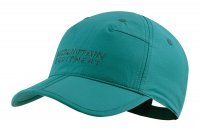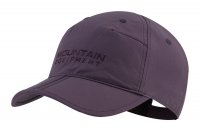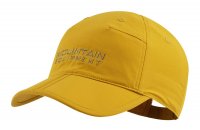This product has been discontinued
Click on the image above or here to see its replacement.
Preface
As always, we're looking at the Mountain Equipment Tuolumne from the point of view of long distance trekking over tough terrain.
Test subject: Head circumference: 57.5cm (22.5") = Medium
Test item: 2019 Tasman Blue (One Size)
Kit Tests: Winter (Summer - Pending)
Disclaimer: None required (item not provided by manufacturer)
Datasheet
| Materials: Exolite 125 stretch double weave (Nylon / Elastane) | 94% / 6% |
| Treatments: | DWR |
| Weight (stated / measured): | 60g / 56g |
| Product Sizing: One Size (Adjustable Strap) | - |
| Manufacturer RRP | £20.00 |
| Scramble's Price on SYSTEM | £17.00 |
Scramble Review
Contents
Introduction: Re-Cap & Re-Visit
In our review of the Ronhill Split Cap (the warm weather cousin of the cap under review here) we opened with the following gambit:
Caps are useful. Whether you're walking head down and headlong into driving rain or hail or require a little shelter and shade from the raging sun, that little item capable of rescuing poorly designed hoods is a practical necessity. No one at Scramble sets off without one.
Unfortunately a cap for all seasons has yet to be designed, and though annoying, there's actually a good reason for this.
Waterproof "baseball" style caps are useful for sub zero temperatures, not because they protect you from the rain and snow (though their brim does - generally they're best worn under a hood of some type), but because their fabric doesn't get saturated and freeze. Putting on a cap that's either frozen solid or just freezing wet, whether over a balaclava or not, is not pleasant in freezing temperatures and ensures you'll lose a good amount of heat and really feel the cold. I've tried it in an attempt to prove to myself only one cap should suffice for all seasons. All I ended up proving was that my waterproof (at the time, Montane Pace Cap) was actually required afterall.
We still stand by almost everything said above ... except the waterproof bit. Until now we've not been able to recommend a cold weather cap; those we've tested have been okay but none have stood out. In retrospect, we've perhaps been too wedded to the idea that a cold weather cap has to be waterproof and this has led to dismissing viable and potentially superior options.
The problem with waterproof caps is that anything with a waterproof membrane will also be effectively windproof and thus by definition not very breathable. The fabrics tend to have little to no stretch; feel clammy when perspiring; are not the most comfortable and rarely allow for a split brim design, so don't pack away easily.
The solution was clearly going to involve some form of compromise. Before we get into specifics ...
What are we after anyway?
There's not a great deal going on with a cap; here's our modest requirements:
- A good sized, deep peak (brim or visor).
- A sensible and functional adjustment mechanism.
- A fabric and weave with a good balance between breathability and wind resistance.
- A fabric with a good degree of stretch to accommodate other winter headwear such as balaclavas and/or beanies.
- A material that has a DWR treatment and/or accepts custom proofing.
- Something that packs down as small as possible.
Enter the Tuolumne Cap.
 The Tuolumne worked well beneath hoods and over balaclavas and beanies.
The Tuolumne worked well beneath hoods and over balaclavas and beanies.
Materials & Design
The Tuolumne is made from Mountain Equipment's Exolite 125, the same durable, stretch, double weave softshell fabric (94% nylon, 6% elastane) used on their Echo Hooded Jacket.
In terms of design, the Tuolumne is almost identical to the excellent Ronhill Split Cap. It has the same split visor at the front; the same velcro adjustment at the back. The differences are largely down to the materials. The Tuolumne is tougher (just as nylon is tougher than polyester) and consequently can better handle the rough and tumble of winter conditions.
 Similar to the Ronhill Split: A packable split visor and a velcro adjustment at the back.
Similar to the Ronhill Split: A packable split visor and a velcro adjustment at the back.
The Tuolumne has a quality feel to it. On the inside the seams are reinforced with a strong fabric backing, which provides a degree of airflow between the scalp and the main surface.
 The Tuolumne's seams are reinforced with a strong fabric backing.
The Tuolumne's seams are reinforced with a strong fabric backing.
The only other departure from the Ronhill Split is the Tuolumne's vents that circle the upper section of the cap (pictured below). The Exolite 125 fabric provides sufficient wind resistance to take the edge off a biting wind; the addition of vent holes helps supplement its breathability. Over-heating, no matter the combination of winter headwear, has not been an issue.
 The Tuolumne's vents circle the upper section of the cap.
The Tuolumne's vents circle the upper section of the cap.
The extremely comfortable Tuolumne was on my head almost the entire time I was active during the 2020 winter kit test. What varied was what it was under (waterproof, insulated jacket) and what it was over (naked head, balaclava, beanie or all three).
Being a split cap, it's conveniently packable and easy to stow away in a belt bag or pocket.
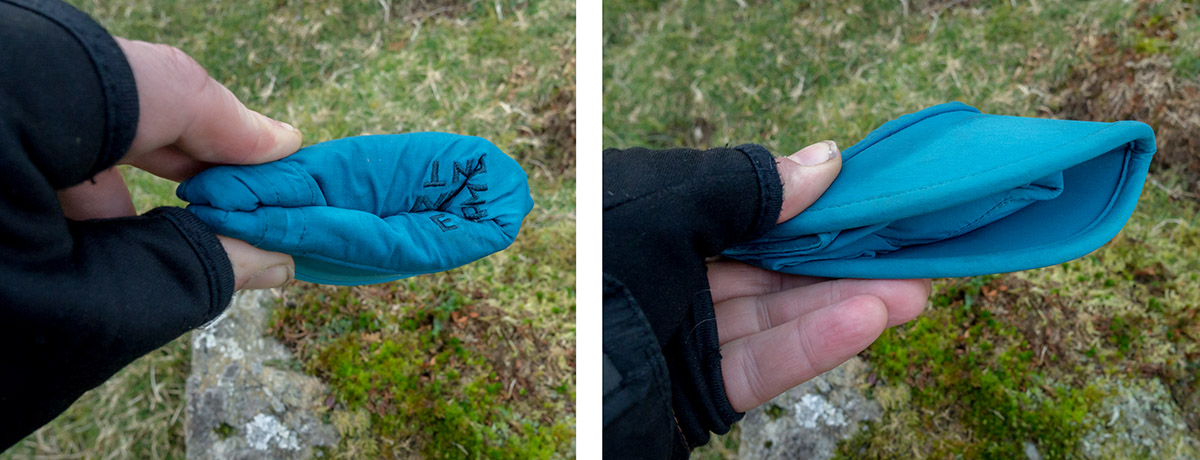 Like the Ronhill Split, the Tuolumne has a small packsize.
Like the Ronhill Split, the Tuolumne has a small packsize.
Strangely, Mountain Equipment currently make two very similar split caps. Both are softshells, both use the same Exolite 125 fabric and both weigh about the same. The other cap is the better known Squall Cap. The only differences between the two is that the Tuolumne (is harder to pronounce, and) has vent holes; the Squall has a mesh lined inner front panel. Apart from that there's very little difference. We think the Tuolumne is the superior option, but the Squall isn't far behind.
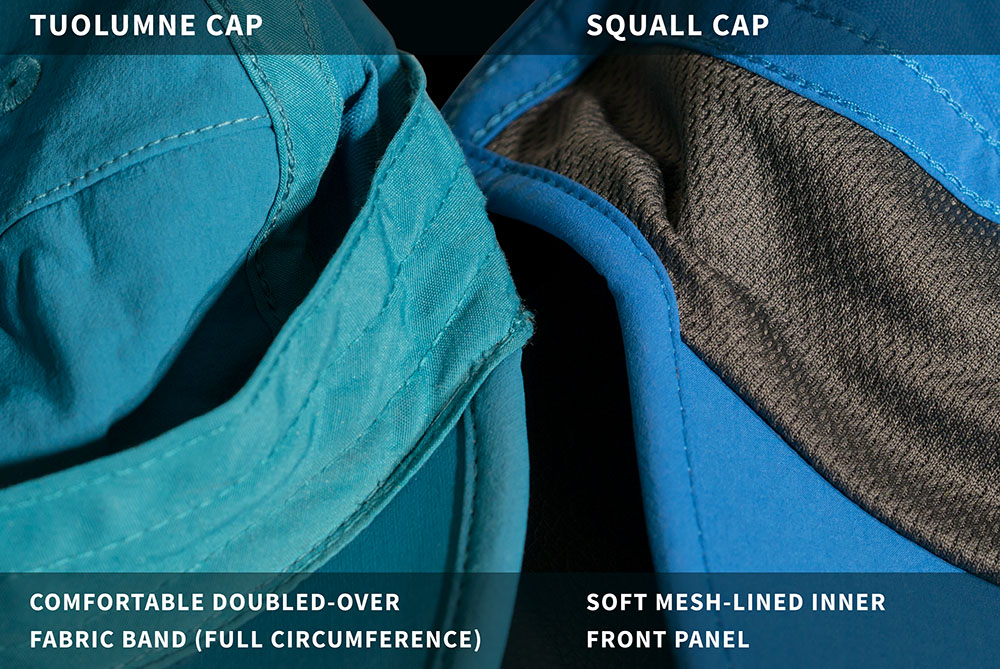 Inside-out: the Tuolumne has a comfortable inner band which covers its circumference.
Inside-out: the Tuolumne has a comfortable inner band which covers its circumference.
Here's the state of caps as we see it:
- If you can have three: Ronhill Split for hot summer conditions, Squall for (UK) spring / autumn conditions, Tuolumne for winter.
- If you want just two: Ronhill for hot summer conditions, Tuolumne for the rest.
- If you're forced to have just one: The Tuolumne
Finally, the Tuolumne is treated with a good water-repellent (DWR) coating. Though not absolutely necessary, I've reinforced just the visor split cap section with Fabsil Gold. This has no effect on breathability (since it's just the visor section) but does help prevent the cap getting overwhelmed / saturated during extreme downpours.
In a previous winter kit test (when I was testing whether a winter cap was really necessary), the (DWR-free) polyester of the Ronhill got saturated and then froze overnight. The DWR of the Tuolumne did a great job of preventing the cap from wetting out. Further, the Exolite fabric dries out very quickly. Each night, I was able to pack the cap away and it was fine the next morning (though it wasn't extremely cold, temperatures were below freezing, 0 to -5°C).
Any Negatives?
The only negative we can muster, is that it's not the ultimate universal all-weather cap. The Tuolumne is unlikely to out-do a running cap like the Ronhill Split in hot conditions. That said, I'm going to bring it along for the ride this summer and hopefully I'll be able to see how it fares under the baking sun. We'll update this review if we discover anything interesting.
Conclusion & Rating
The Mountain Equipment Tuolumne Cap is what you'd get if you made a Ronhill Split Cap for sub zero mountain conditions. It provides an ideal balance between wind resistance and breathability; it's extremely comfortable, packable, light weight and durable. I should add, Mountain Equipment have impressed us recently. They're churning out a good number of simple, well executed designs, finished to a high standard. The Tuolumne is a good example and our top pick in the Cold Weather Trekking Cap category. Which is probably a cue for them to cease its production.
Product Images
Rating (out of 10)
* The value score is derived from two factors:
1) Competitive Market Price (CMP). This represents our judgement of a competitive online price point if we were to stock the item. e.g. if we feel we would need to sell an item at 40% off (i.e. 60% of its full RRP) to be competitive, then our CMP score will be 6/10.
2) Customer Value Price (CVP). We then make an honest appraisal of the maximum price we would be willing to pay for the item (and we're mean). So if we'd pay 80% of its RRP our CVP score would be 8/10.
We then average the two scores to get our final value score, which in our example would be 7/10.
Last Updated: 14/04/20



